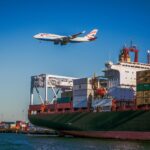Truckload
Have confidence in HTR to be your domestic logistics solutions provider. From the most time sensitive to the most cost-effective transportation solutions, we take advantage of our extensive resources to deliver the services you need. HTR’s domestic services provide flexible solutions for virtually any size company.
What is a dry van?
A dry van is a type of semi-trailer that’s fully enclosed to protect shipments from outside elements. Designed to carry palletized, boxed or loose freight, dry vans aren’t temperature-controlled (unlike refrigerated “reefer” units) and can’t carry oversized shipments (unlike flatbed trailers).
Also called a “dry van trailer” or “box trailer,” dry vans can be used for a variety of less-than-truckload (LTL) or truckload shipment types. If you’ve ever shipped or received freight, it’s likely your goods traveled on a dry van.
Dry vans come in a variety of sizes:
- 53-foot trailers – The most common types of dry vans on the road, typical dimensions for these trailers are 53’ x 8’ 6” x 8’ 6” (lwh). They can accommodate up 45,000 pounds of freight and up to 26 standard pallet positions across their floor space.
- 28-foot trailers – “Pup” trailers are commonly used for moving LTL shipments. Measuring 28’ x 8’ x 9’ (lwh), they can accommodate up to 22,500 pounds of freight and 14 standard pallet positions across their floor space.
- Straight trucks – Straight trucks, also referred to as box trucks, are typically used for city deliveries and often feature a lift gate. Straight trucks come in a variety of sizes, commonly measuring 24’ x 8’ x 8’ 6” (lwh).
Benefits of dry van shipping:
- Versatility – Because they work well for transporting consumer packaged goods, dry vans are the most frequently used equipment type. Products such as clothing, furniture and electronics are commonly shipped via dry van trailers, though they also can be used to move machinery and parts, nonperishable foods and even household goods.
- Protection – One of the biggest advantages of using a dry van truck to move your freight is the protection it provides — because the equipment is enclosed on all sides, shipments are shielded from weather hazards like high winds, rain or direct heat. The enclosure and ability of the trailers to be locked also provides a layer of protection against cargo theft.
- Affordability – Dry vans are readily available from a variety of carriers and don’t require service extras or special operation, making them one of the most affordable shipping options
Flatbed shipping is transportation for cargo that may not require the enclosure of a dry van, cannot be loaded or unloaded from a dock or does not fit within the dimensions of standard truck trailers. A flatbed’s design allows for cranes and forklifts to load goods from all angles.
Benefits of flatbed shipping:
- Flatbed shipping provides some dimensional flexibility for large freight since there are no physical walls.
- Where dry van trailers are loaded from the rear, flatbed trucks can be loaded from either side, as well as the top and back.
- Flatbed equipment includes step decks, double drops and RGNs
Common flatbed shipping questions:
- What are the typical dimensions of a flatbed trailer? A legal flatbed trailer is typically 48’ long and 8.5’ wide, with varying deck length for step decks, double drops and removable goose necks (RGNs). When loading a flatbed trailer, shippers need to be aware of the maximum height and width allowed on roads. Our helpful experts can guide you through those determinations.
- What are some common types of flatbed trailers? Legal flatbeds, step decks, double drops and RGNs are some of the most common flatbed trailers used for shipping.
- Are tarps required for all shipments? Not all flatbed loads require a tarp. With this in mind, it’s important to find a truck that is properly appointed should you need one.
- How are products loaded and unloaded onto flatbeds? The process to load flatbed shipments is dependent upon the particulars of the shipping location and the type of cargo being handled. If your goods require the use of a crane for loading, take steps to ensure the appropriate equipment is available when your truck arrives for the most efficient operation.
- Are additional accessories required when shipping via flatbed? Similar to tarps, the required use of items like chains or corner protectors should be conveyed when booking the shipment. This way, your freight service provider can help designate the appropriate truck for your shipment.
The Federal Highway Act of 1956 created the Federal Highway Administration (FHWA) to oversee the nation’s interstate infrastructure. Further changes and amendments in the coming decades resulted in the creation and classification of the National Network (NN). The NN was authorized by the Surface Transportation Assistance Act (STAA) of 1982 and specified in the U.S. Code of Federal Regulations (23 CFR 658).
These rules were codified to preserve national infrastructure and promote safety in normal times. Conventional vehicle combinations allowed on the NN are tractors with one semi-trailer up to 48 ft in length or with one 28 ft semi-trailer and one 28 ft trailer, each up to 102 inches in width. Anything longer or wider is prohibited on the NN unless special permission is given by the states. The transportation of oversized and overweight loads can be done provided sufficient safety precautions are met, which are detailed below.
Generally, the maximum length of a flatbed truck trailer allowed is 48 ft, however, 25 states allow 53 ft long trailers without permits. So the heart of the matter is down to the dimensions of the oversized cargo as the flatbed truck itself is largely modular and standardized across the country.
OVERSIZE LOAD DEFINITIONS
According to the Federal government, an oversized haul is a vehicle and/or shipment that is wider than 8 ft 6 in (102 in), whose gross vehicle weight (GVW) is over 80,000 pounds. Most states have a max height limit of 13 ft 6 in (162 in), with overpasses on the NN constructed for a maximum height of 15 ft.
Vehicle legal weight falls under the following classifications:
- 80,000 lbs GVW
- 20,000 lb single axle weight
- 34,000 lb tandem axle weight
Anything over these limits needs a permit. However, other criteria need to be met before a state will issue a permit.
OVERSIZE LOAD PERMITS ARE GRANTED IF LOAD MEETS NON DIVISIBLE EXCEPTION
Flatbed drivers will not be granted permits for any cargo that is reasonably divisible. Nondivisible loads are defined by the FHWA as any load or vehicle exceeding applicable length or weight limits which, if separated into smaller loads or vehicles, would:
Compromise the intended use of the vehicle, i.e., make it unable to perform the function for which it was intended; Destroy the value of the cargo or vehicle, i.e., make it unusable for its intended purpose; or require more than 8 work hours to dismantle using appropriate equipment. The applicant for a nondivisible cargo permit has the burden of proof as to the number of work-hours required to dismantle the cargo.
Complicated pieces of machinery cannot be trivially disassembled, nor can the structural integrity of an airframe be maintained if it is cut in half only for transport. Yet if you need to transport 100,000 lbs of scrap iron and you are on a tight schedule – you likely can easily ship 80,000 lbs and 20,000 lbs without requiring a permit.
As always, limitations are determined by states and some states will allow oversized shipment permits for non divisible loads, although the vast majority do not. Check with local state contacts for whether your oversized cargo needs to be non divisible.
Refrigerated truckload trailers, commonly referred to as reefers, will contain a shipment that requires its temperature to be controlled, monitored, and maintained within specific limits. Reefer can apply to FTL, LTL, intermodal, ocean, and air freight. The most common products that require reefer freight are food, chemicals, and pharmaceuticals.
Refrigerated trailers are similar to standard 48’ or 53’ dry van trailers, but there are a few important differences:
- The walls, ceiling and floors are made of metal or fiberglass, never wood. This not only improves insulation, but it prevents the floors and walls from absorbing odors from product.
- Between the heavier construction materials and refrigeration unit, refrigerated trailers are heavier. The maximum loadable weight for a 53’ refrigerated trailer is 43,500 lbs.
- Trailers are typically newer. Refrigeration units burn out after a few years of continuous work, and carriers typically must replace trailers every three to five years.
- In reefer freight, temperature control falls into three main categories:
- Frozen: The standard is that the freight must be kept at -10 degrees F.
- Refrigerated: This freight is typically kept at 32-36 degrees F.
- Heated/maintained: If its 16 degrees outside, and the freight needs to be maintained at 32, the reefer technically acts as a heater.
Other Services
We specialize in providing international, domestic, and oil and gas services that can be scaled and customized to our customers’ needs.

LTL
LTL stands for “Less than TruckLoad” or “Less Than Load.” LTL shipping is used for freight that is too large to take to the post office but too small for an entire truck.

International International Air & Ocean
Our import and export services help you navigate the latest regulations, accelerate transit, and lessen shipping costs.

Intermodal
Intermodal transportation uses two or more modes or carriers to transport freight from shipper to consignee.

Expedited Services
Our expedited services and hot shot trucking provide you with solutions in a pinch. With non-stop delivery from point A to point B, we deliver your goods on time.

HTR Logistics is fully dedicated to understanding customer expectations and providing first class supply chain management solutions in a manner that meets our customer’s needs. Our operating philosophy is founded on maintaining the highest level of quality service in the most efficient manner possible. We are committed to continuous process improvement through leadership, innovation, and technology.
